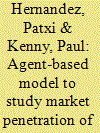|
|
|
Sort Order |
|
|
|
Items / Page
|
|
|
|
|
|
|
| Srl | Item |
| 1 |
ID:
105798


|
|
|
|
|
| Publication |
2011.
|
| Summary/Abstract |
A spatially explicit agent-based vehicle consumer choice model is developed to explore sensitivities and nonlinear interactions between various potential influences on plug-in hybrid vehicle (PHEV) market penetration. The model accounts for spatial and social effects (including threshold effects, homophily, and conformity) and media influences. Preliminary simulations demonstrate how such a model could be used to identify nonlinear interactions among potential leverage points, inform policies affecting PHEV market penetration, and help identify future data collection necessary to more accurately model the system. We examine sensitivity of the model to gasoline prices, to accuracy in estimation of fuel costs, to agent willingness to adopt the PHEV technology, to PHEV purchase price and rebates, to PHEV battery range, and to heuristic values related to gasoline usage. Our simulations indicate that PHEV market penetration could be enhanced significantly by providing consumers with ready estimates of expected lifetime fuel costs associated with different vehicles (e.g., on vehicle stickers), and that increases in gasoline prices could nonlinearly magnify the impact on fleet efficiency. We also infer that a potential synergy from a gasoline tax with proceeds is used to fund research into longer-range lower-cost PHEV batteries.
|
|
|
|
|
|
|
|
|
|
|
|
|
|
|
|
| 2 |
ID:
111364


|
|
|
|
|
| Publication |
2012.
|
| Summary/Abstract |
As the U.S. federal government is seeking useful applications of Vehicle-Infrastructure Integration (VII) and encouraging a greener and more efficient automobile industry, this paper demonstrated a path to meet the national transportation goal via VII. An impact study was conducted in a midsize U.S. metropolitan area on the potential of utilizing VII communication in Hybrid Electric Vehicle (HEV) operations by simulating a VII-enabled vehicle framework for both conventional HEV and Plug-in Hybrid Electric Vehicles (PHEV). The data collection and communication capability of the VII system allowed the prediction of speed profiles at the vehicle level with an average error rate of 13.2%. With the prediction, at the individual vehicle level, VII technology allowed PHEV and HEV to achieve additional benefits with an approximately 3% decrease in total energy consumption and emission. At the network level, the benefit-cost analysis indicated that the benefit-cost ratios for PHEV and HEV of the VII vehicle network exceed one at the fleet penetration rate of 20% and 30%, respectively. Our findings encourage to support public and private investments in VII infrastructure and its integration with HEV and PHEV in order to reap the increased energy savings from these vehicles.
|
|
|
|
|
|
|
|
|
|
|
|
|
|
|
|
| 3 |
ID:
116969


|
|
|
|
|
| Publication |
2012.
|
| Summary/Abstract |
Electrified vehicles can reduce greenhouse gas (GHG) emissions by shifting energy demand from gasoline to electricity. GHG reduction potential depends on vehicle design, adoption, driving and charging patterns, charging infrastructure, and electricity generation mix. We construct an optimization model to study these factors by determining optimal design of conventional vehicles, hybrid electric vehicles (HEVs), plug-in hybrid electric vehicles (PHEVs), and battery electric vehicles (BEVs) with optimal allocation of vehicle designs and dedicated workplace charging infrastructure in the fleet for minimum life cycle cost or GHG emissions over a range of scenarios. We focus on vehicles with similar body size and acceleration to a Toyota Prius under government 5-cycle driving conditions. We find that under the current US grid mix, PHEVs offer only small GHG emissions reductions compared to HEVs, and workplace charging is insignificant. With grid decarbonization, PHEVs and BEVs offer substantial GHG emissions reductions, and workplace charging provides additional benefits. HEVs are optimal or near-optimal for minimum cost in most scenarios. High gas prices and low vehicle and battery costs are the major drivers for PHEVs and BEVs to enter and dominate the cost-optimal fleet. Carbon prices have little effect. Cost and range restrictions limit penetration of BEVs.
|
|
|
|
|
|
|
|
|
|
|
|
|
|
|
|
|
|
|
|
|